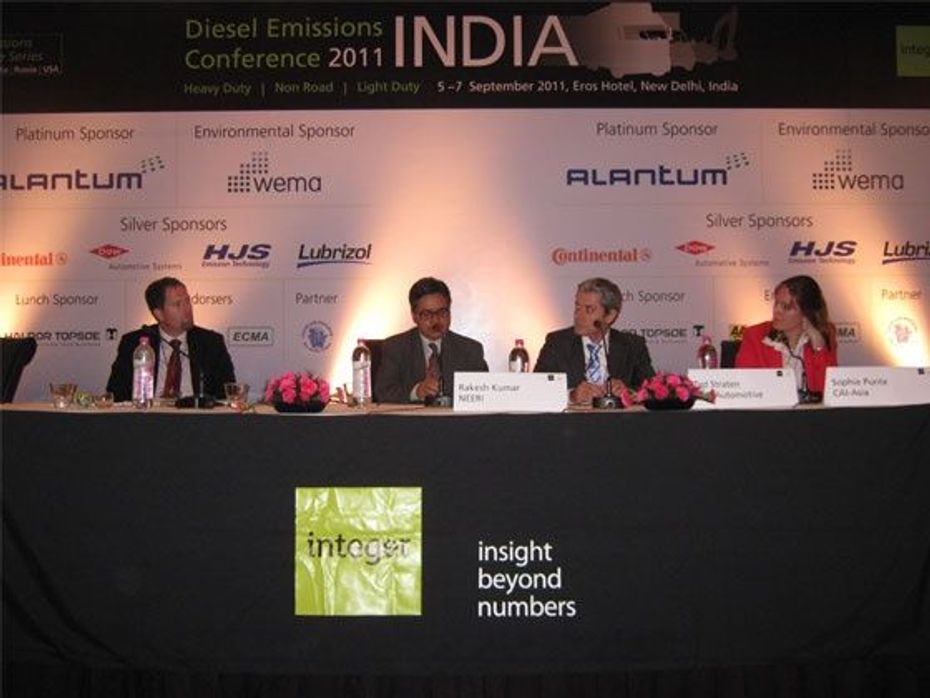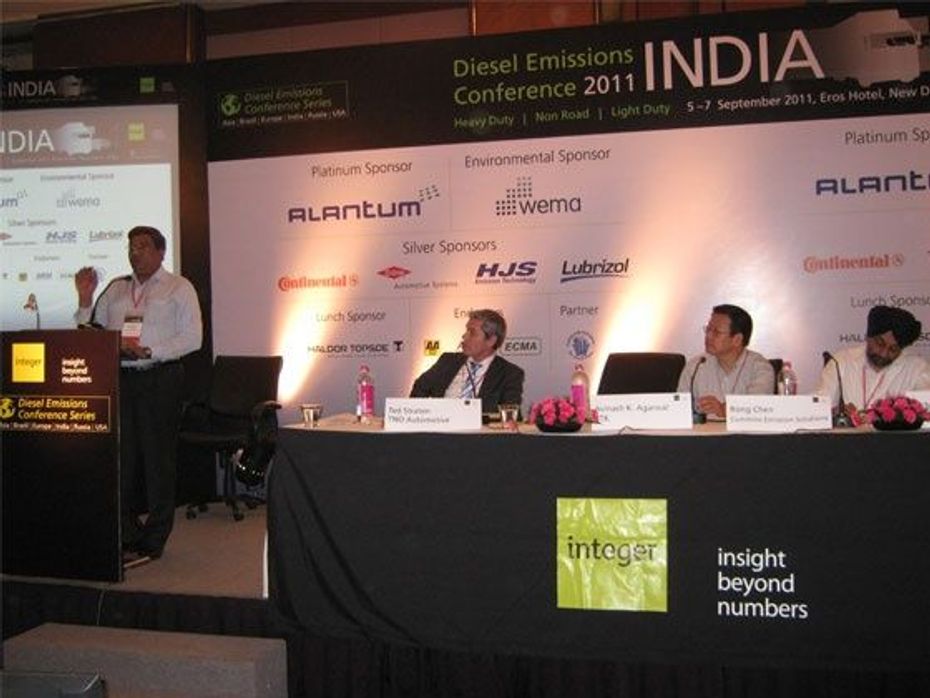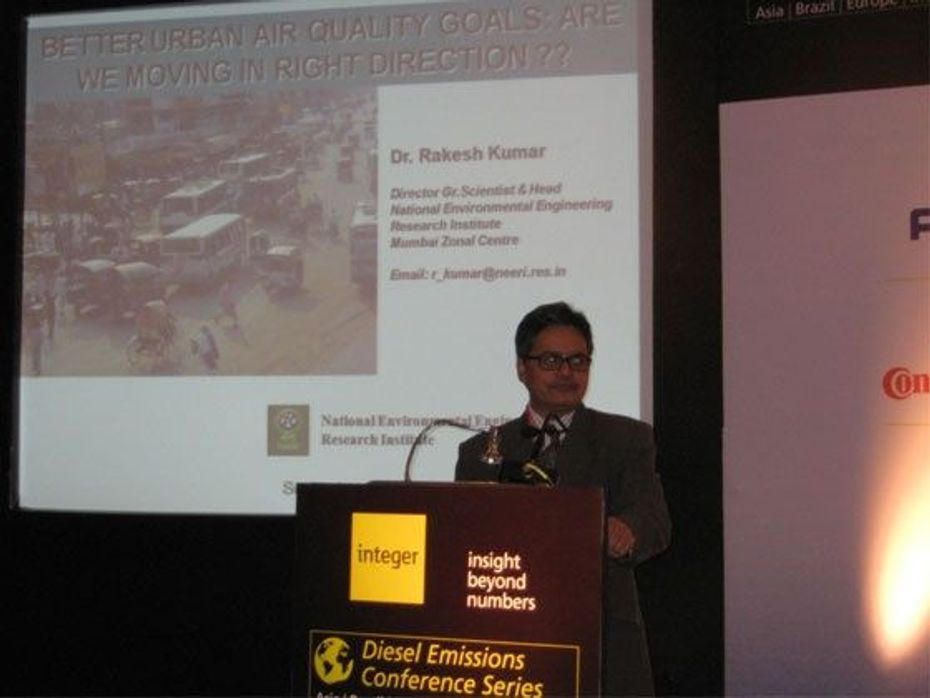
3 New Major Design Details Mahindra XUV 3XO Will Pack Over...
- Apr 12, 2024
- Views : 9803

The three day Diesel Emissions Conference was an exhaustive event which discussed every aspect of reducing emissions from the diesel internal combustion engine taking into consideration all possible variables influencing the movement.
The Government of India is planning to reduce air pollution from the transport sector in the country. There are a lot of technical and logistical hurdles which have to be overcome if emissions from diesel engines in this country are to be reduced.
According to the solutions discussed for reducing emissions the conference can broadly be divided into three sections. One was the introduction of Euro IV engines nationwide. The second was about making Euro IV fuel available nationwide. And the third was about technology that can be integrated into existing engines to make them meet Euro IV pollution norms, thereby reducing emissions from older engines.

Sophie Punto, Executive Director, CAI-Asia, made a speech by suggesting a Public Private Partnership in the emissions reducing movement. In which case, the Public sector could look after the aspect of making available to the nation Euro IV compliant technology and fuel for new and old vehicles alike. While the Private sector could take care of implementing the movement by adding incentive based schemes for those who would upgrade to lesser emissions technology. The Government can also finance schemes to implement emissions reduction programmes. However, the drawback of the private sector’s profit motive hampering the movement cannot be overlooked.
Under an analysis for further reducing vehicle emissions in India, it was brought to everyone’s attention that before any investment is made to the infrastructure of the transport sector various aspects have to be rectified first. Those aspects include limited and poor road network which increases fuel consumption and maintenance costs of vehicles. Unless the road network is improved fuel consumption will continue to remain abnormally high, no matter what emissions control technology is implemented. Travelling at a constant moderate speed will reduce fuel consumption rather than having bad roads and speed breakers which has resulted in an aversion from speed for the Indian driver. Truck drivers have to be educated about the right way of driving vehicles for economy, increments for economical driving to the drivers proved to be a strong point to achieve low carbon emissions.
It was brought to notice that better quality low rolling resistance tyres should be mandatory on commercial vehicles to reduce fuel consumption.
The biggest challenge of reducing emissions in the transport sector was rightly pointed out to be the overloading of trucks. Overloaded trucks cause excessive stress on the engine which leads to more pollution. Also, excess weight puts added stress on various mechanical components of the vehicle which means that they wear out faster. Only when the issue of overloading is brought under strict legal regulation will it stop.
The Conference discussed two methods that can be implemented to reduce air pollution from diesel emissions one being Exhaust Gas Recirculation (EGR) and the other was Selective Catalytic Reduction (SCR).
Exhaust Gas Reduction or EGR uses technology integrated into the engine and exhaust manifold. Exhaust gases from the manifold are re-circulated back into the intake manifold which mixes with oxygen and goes into the cylinders for combustion. NOx forms when nitrogen and oxygen mix in high temperatures. In EGR systems the combustion temperature is lowered which reduces NOx gases during combustion. A Diesel Particulate Filter (DPF) is used to filter out soot from combustion gases which flow back into the engine. In EGR systems abrasive contaminants in exhaust gases flow back into the engine which can harm the engine and lower its life span because of which a lot of expensive components are used to protect the engine. EGR is relatively more expensive than SCR systems.

Selective Catalytic Reduction or SCR uses equipment to treat exhaust gases and reduce emissions in the exhaust manifold before the exhaust gases are released into the atmosphere. SCR is relatively cheaper and easier to integrate into a new or old vehicle. SCR uses a Diesel Particulate Filter (DPF) in the exhaust manifold to remove some of the soot and harmful gases from exhaust gases. SCR also uses something called AdBlue (aqueous urea solution) which is pumped into the exhaust manifold where it mixes with exhaust gases to reduce NOx emissions.
Whatever technology is chosen to reduce emissions in India it has to be kept in mind that there is a lot of dust in our atmosphere. Dust can hamper these technologies as a result these systems have to be tested in the country and developed to reduce emissions in these dusty conditions.
While it is possible to integrate these systems to diesel engines for reducing emissions as seen from other parts of the world, their implication in India would require a different approach as the Indian psyche is very different from that of other nations. Tackling diesel emissions is a complex problem. It was rightly mentioned that no one cares about diesel emissions in India. Most owners of commercial or private vehicles do not maintain them well. As a result any emission reducing technology incorporated in vehicles will not be maintained and will become defunct in some time leading back to higher emissions. Also, these technologies cannot be repaired by the typical roadside mechanic in India who will not know how to keep them working properly. Indians have to change their mentality of going to roadside mechanics instead of authorised service centres who know how to perform proper repairs on their vehicles. Only once that happens will the country be ready to accept and use EGR and SCR technologies effectively.
The Diesel Emissions Conference brought to notice the increasing number of diesel passenger vehicles in India. It was mentioned that people who drive diesel cars in this country are least concerned about the environment and bother only about savings on fuel costs. Again, most these people also go to road side mechanics to repair their cars as a result any emissions reducing technology fitted to their cars will become defunct. Many speakers mentioned that technology and systems have to be developed which can catch atleast a minimum percentage of polluting vehicles and strict fines have to imposed so that people bother to maintain emission reducing components on their cars and keep them functioning.
The Indian public is migrating from public transport into their vehicles due to rising cost of public transport fares, unless fares are subsidised the number of vehicles on the road will continue to rise leading to more air pollution.
This is reflecting on vehicle registration figures as 60% of passenger diesel vehicles in this country are small diesel cars, 20% are large diesel cars and the remaining 20% are in the transport sector. Diesel vehicles contribute to as much as 61% of pollution in Indian cities.

For non-road diesel internal combustion engines it is mush the same scenario as most industries are based in rural areas where Euro IV fuel is not available. A large chunk of pollution comes from industries and the sooner the Government works out the logistics of standard fuel supply throughout the country especially in Special Economic Zones (SEZ) where industries are located new technologies such as EGR and SCR can be implemented to reduce emissions. In the mean time natural gases such as CNG and LPG can be used for non-road engines in and around cities where they are supplied. A reason for slow implementation of low emissions technology in non-road engines is because we are a developing nation and the cost of the technology is high, which means affordability is an issue. It was put forward that the Government could subsidise emissions reducing technology that has to be integrated into non Euro IV engines so that industries can afford the technology. 44% of commercial vehicles in the transport sector were registered before the year 2000, these vehicles should be scrapped under a government scheme to reimburse the owners or give discounts on new vehicles so as to have new cleaner vehicles on the road.
Because SCR is a simpler and more affordable way of reducing emissions the business of growing urea for AdBlue technology was discussed. It was put forward that from the right grade of urea should be certified before it is grown to maintain AdBlue quality. Urea prices should be stabilised by the government so that people can afford to refill their AdBlue tanks as and when needed. The supply chain for urea to petrol pumps has to be setup so that people can refill their tanks.
The biggest challenge as pointed out by every one at the conference was educating drivers, operators and owners of engines using AdBlue technology about the system. On-board diagnostics should be developed to tell the driver or operator of the engine (as the case may be for vehicles and non-road equipment) about the status of the system and AdBlue levels in the tank so that it can be refilled as and when needed.

There were talks about making Euro IV fuel available throughout the country so that Euro IV engines can be made standard in the country to reduce emissions. A lot of logistical problems were pointed out that will take time to supply Euro IV fuel throughout the country. The target is to make Euro IV fuel available in 50 Indian cities by 2015. Talks about alternative fuels like bio diesel and CNG being made available instead of Euro IV fuel came up, but it is unlikely that any of that will have an adequate supply and infrastructure throughout the country. For the foreseeable future diesel will contribute to be the backbone of economies worldwide, it is therefore important that India targets low fuel emission technologies at the earliest. The movement has to be a grass roots level one so that everything from growing urea to AdBlue supply chain, Euro IV fuel supply, educating drivers and operators about SCR or EGR technology, due diligence about maintenance of the technology and monitoring pollution levels of industries and vehicles alike.

3 New Major Design Details Mahindra XUV 3XO Will Pack Over...

Tata Curvv: A Much Clearer Look At Its Interior Ahead Of Its Unveiling

Citroen Basalt vs Tata Curvv: Exterior Design Compared

10 New Features Expected In The Upcoming 2024 Mahindra XUV 3XO...

The Fronx Has Been Rebadged! Meet The Toyota Urban Cruiser Taisor,...

Here’s How Fuel Efficient The 2024 Maruti Suzuki Swift Sold In...

MG Hector And Hector Plus Blackstorm Edition Launched At Rs 21.25...

Mahindra XUV300 Facelift Teased, Gets A New Name

Citroen Basalt Vision, Its SUV Coupe For India, Revealed
India's largest automotive community